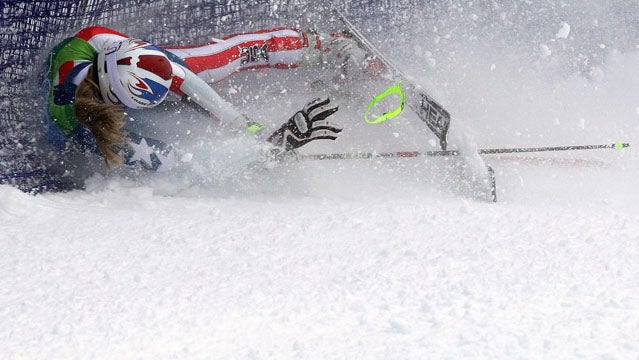I had no idea, when I finished up the final draft of the profile of Lindsey Vonn that ran in the February issue, what an eventful season she would end up having on the World Cup this winter.
The Fastest Woman on the Planet
The Lindsey Vonn profile from our February 2013 issue.Video
Lindsey Vonn’s crash. Lindsey Vonn in March 2008.
Lindsey Vonn in March 2008.“[B]arring serious injury,” I wrote, “it’s entirely possible that Vonn will win more races this season than she ever has before.”
Anyway, I spoke too soon. As has been widely reported, here and elsewhere, Vonn landed awkwardly coming off a jump in super G at the World Alpine Ski Championships in Schladming, Austria, on Tuesday, tearing two of the four major ligaments in her right knee and fracturing her right tibia. (Universal Sports has an , including a new, hard-to-watch angle, and an interview with her surgeon, Dr. William Sterret, who gives a relatively positive prognosis for her recovery.)
Crashes are a fact of life in ski racing, of course—on Wednesday, Norway’s Kjetil Jansurd , ending his season. And during her years as a junior racer and as a U.S. Ski Team rookie, Vonn had a reputation for crashing hard as much as she did for winning races. As Todd Brickson, one of Vonn’s coaches on the U.S. development team, told me, Vonn frequently frightened the daylights out of the adults responsible for her safety. “She was very tall, and very thin,” Brickson said. “She would push herself so hard, and take such horrendous crashes. She crashed more than anyone else on the team. Really hard crashes, where you thought she wasn’t going to get up.” Still, Brickson said, Vonn had a knack for falling—relaxing as she lost control, perhaps because, unlike many other skiers, she wasn’t afraid of speed and therefore wasn’t tense to begin with.
Early on, fears about Vonn’s long-term health led Brickson and other coaches to pressure Vonn to stay away from the speed events. According to several people I spoke with for the story, when Vonn was 16, a dispute over whether she should race downhill at the World Junior Championships in Whistler escalated into a shouting match between her father and the U.S. development coaches, who were worried she was over-raced and might get hurt.
Unlike several women’s phenoms, Janica Kostelic and Mikaela Shiffrin in particular, it took Vonn years on the World Cup before she could win consistently, and between 2002 and 2006 she had many more DNFs than podiums. Until yesterday, Vonn’s most famous wreck was a bruising fall in training at the Torino Olympics, when she did a split going 60 miles per hour and whiplashed backwards down the hill; for several hours, both Vonn and those who had seen the fall assumed that she had broken her spine.
In recent years, though, Vonn has learned that she can race at 90 percent intensity and still win. According to U.S. downhiller Stacey Cook, this was one of Thomas Vonn’s most important contributions during his tenure as Lindsey’s coach.
The other thing that transformed Vonn from a crashing hazard into a champion was her fitness program, which is the most comprehensive on the women’s World Cup. In years past, Vonn's fitness has allowed her to maintain her balance and body position through choppy sections of downhill and super G, and especially to keep a tuck much longer than her competitors. “In downhill and super G, you’re always in an isometric position, holding power on the skis, holding position,” Martin Hager, her trainer, told me this summer. Often, that means the stronger skier is the faster skier, and since 2007 it has meant that Vonn's 90 percent is good enough to win.
It's fair to assume that Vonn was not skiing at 90 percent in Schladming. The stomach virus that forced her into the hospital twice since November seems to have robbed her of some fitness, and in several races this season she has looked shaky and unsteady, even in victory. More, Vonn was chasing Tina Maze, who had posted the fastest time of the day and who is having the best season of any woman in skiing history. It's likely she was out of her comfort zone. In an email on Wednesday, NBC's Steve Porino told me that he didn't think Vonn's fitness had caused her knee to give out, but, he wrote, “if there is a link to prior events, I'd say it's that Vonn wanted very badly to re-establish her dominance and was at the limit from 'Go.'”
Taken together, Vonn’s crash begins to make a little more sense. It snowed in Schladming on Monday, leaving racers with poor visibility and a course in rough condition. Vonn charged the upper two sections and led Maze by half a tenth. Three gates before she fell, she was bounced into the back seat and recovered into a too-straight line. She hit the jump fast and moved ever-so-slightly to the left in the air, sighting the next gate. Maybe a year ago she could have pulled it off. Not this winter.


